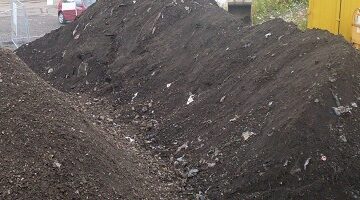Classification and disposal of waste is something of a hot topic at the moment and frankly it’s a bit of a minefield, so we thought we’d offer a few (ok quite a few), words and try to clarify things a wee bit. As a waste producer you have a duty of care to ensure that you have adequately characterised your waste for disposal. So assuming that you’ve been through the waste hierarchy, attempted to minimise your waste and carried out any available pre-treatment and you still need to take material to landfill what analysis do you need? When we talk about waste here we’re really envisaging contaminated soil but some of this will apply to other waste streams as well.
Firstly we need to dispel a commonly held misconception, Waste Acceptance Criteria (WAC) testing cannot be used to determine whether a waste is hazardous or not. Whether a waste is hazardous is dependant upon the Hazardous Waste Regulations and is established by reference to the Hazardous Waste List of the European Waste Catalogue. Simple right?
Essentially WAC testing is to determine how a waste will behave once it’s buried in a landfill, primarily by analysis of leachates derived from that waste. So a WAC test will tell you how to characterise your waste and whether it will meet the acceptance criteria of the landfill site but this is actually a separate issue from classification as Hazardous or Non-Hazardous. Most waste (except those which are classed as absolute hazardous or meet the criteria to be classed as inert without testing), will therefore be classified on the basis of a standard range of inorganic and organic chemical analysis such as that carried out during a Phase II Site Investigation which can be screened against the Hazardous Waste List. Although if you are using SI data be careful that the previous sampling matches the material you want to dispose of.
Once you have determined whether your waste is hazardous or non-hazardous you then have to establish what is an appropriate disposal route. Which for you, if you are the waste producer, is where WAC testing comes into things. Broadly speaking if it’s hazardous you will require WAC analysis but if it’s non-hazardous you may not, unless you believe it to be inert. You will have to provide background information about your waste and there are other factors which must be considered such as on-site processes that could complicate this. So if you’re intending to send your waste to a landfill site then they probably will require WAC analysis to determine whether it meets the restrictions of the site’s licence and how they should handle this material once it’s through their gate. There can be considerable variation between landfill site licences so ask them if they require this information, don’t just assume that they will, you may get a pleasant surprise. WAC analysis is expensive and time consuming, and due to the processes involved it really cannot be turned around any faster, no matter how much you beg the nice people at the lab.
So plan ahead, look at the information you already have and ask the question first, you could save yourself a lot of time and money.
We will undoubtedly be writing more on this in future but until then if you have any waste classification issues which you need some help with give us a call (0131 5388456) or drop us an email.
2022
Waste soil classification and disposal options
Classifying waste soils for disposal without any prior knowledge can be difficult and uncomfortable at times, especially when it can be very costly if you incorrectly classify the material. This eBook will help you understand the whats, the whys and the hows of waste soil classification in the simplest terms.







Leave a Reply